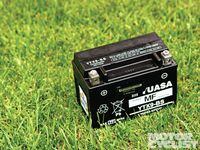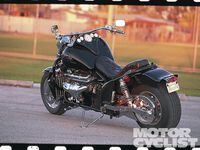Got A Question For Answers? Send It To mcmail@sorc.com
Back From The Dead
I have a very well preserved 1969 Honda CB750 in the garage that fires instantly every time I push the button. Or at least it did until I went on vacation and left it in the garage connected to my formerly trusty 1.3-amp "smart charger" during a nasty hot spell. I returned to find the one-year-old Yuasa YB14L-A2 battery unresponsive, with its plates about 50 percent exposed to the air. Can it be saved, as in refilled with water or electrolyte and recharged? Or should I just chalk the whole thing up to experience and buy a new one?
Eric Pendleton
Lubbock, TX
It’s a good news/bad news thing. According to Alan Kohler in the engineering department at Yuasa Battery, leaving an old-school lead/acid battery to charge unattended for any length of time is a bad idea because the water will evaporate, which you learned the hard way. The good news is there’s a decent chance of resurrecting what you’ve got. “Fill the battery with distilled water, since the acid didn’t evaporate, and give it a good charge,” Kohler says. Here’s the bad news: “The typical life of a conventional battery is two to three years, but it’s likely that this incident has shortened the life of yours considerably.” When it dies, Kohler suggests a maintenance-free absorbed glass mat (AGM) battery like a Yuasa YTX14HL, which can be left connected to an appropriate smart charger with no adverse effects.
Car Tired
A friend of mine recently mounted a car tire on his 1800cc metric cruiser because it was cheaper, cooler, lasted longer and, he claimed, all his friends were doing it with no adverse effects. I have ridden behind him and observed the bike teetering on the edge of the square-profile tire with no contact patch at all. The last time we rode together he carried his 8-year-old daughter on the passenger seat and commented that I was having trouble keeping up. He is an aggressive rider and I just didn't want to take a chance of hitting him. Have you heard of problems caused by car tires mounted on motorcycles? There doesn't seem to be any information about what is fast becoming a common practice.
Gene Quies
Fort Atkinson, WI
Car tires may actually cost less, last longer, ride smoother and make your buddy’s 1800 look cool. But mounting automobile rubber on a motorcycle’s wheels is still dumb, for a host of seemingly obvious reasons. Start with this one from Michelin’s Motorcycle Fitment Guide: “Tires designed for passenger cars can be dangerous when used on motorcycles and motorcycles with sidecars, as bead-seat diameters of motorcycle rims and passenger car rims are different.” Though that difference may not be obvious to the inexperienced eye, it can lead to what experts call “sudden, catastrophic deflation,” which is guaranteed to ruin your day.
Just in case that’s not enough, your pal’s gangsta whitewalls are probably edgier than he thinks. Cars don’t lean much, so car tires are supposed to keep most of their relatively flat tread area on the pavement most of the time. Motorcycles lean to turn, which is why a motorcycle tire’s profile is contoured to lay down a consistent contact patch—upright or cranked over. Automotive tread designs don’t work so well leaning on one edge or the other, especially when it comes to channeling water away from some compromised contact patch. The indecisive cornering feel that comes with it generates more anxiety than confidence; enough to put most right-minded people back on bike-specific rubber. Still, your friend and other adamantly like-minded individuals roll on automotive rubber for the same reason dogs lick their other orifice: because they can. And can, as any good dictionary or tire engineer will tell you, doesn’t mean should.
Slowing Faster
I recently bought a Kawasaki Vulcan 900—my first cruiser after riding a 2002 Kawasaki Concours for 5 years until a chronically complaining left knee took the pleasure out of it for me. The power difference between the two bikes was not a surprise, but the brakes were. What would you recommend to increase the Vulcan's stopping power?
Noel Flores
Miami, FL
The best place to start would be with a set of more aggressive GG or HH-rated brake pads. If that doesn’t produce the desired increase in whoa-power, aftermarket steel-braided lines will transmit force from your fingers to the caliper much more efficiently, delivering extra power with the same effort. According to Jeff Gehrs at BrakeTech USA, the next step would be to determine what size pistons your front caliper uses. “Nissin has radial-pump master cylinders available to work with both 14mm and 5/8-inch piston sizes that deliver a satisfying improvement over the old cross-pull type,” he says. “They come with an integral brake-light switch that should be compatible with the original connector.”
FAQ
With the sun coming up later and going down earlier this time of year, what should I be doing—or not doing—to stay out of harm’s way and make it easier for other drivers to see me when I’m commuting at dawn, dusk and just after dark?
Aside from 2:01 a.m.—right after the bars close—dawn and dusk are the riskiest times to be out on the road. Commuters aren’t at their best, headlights are less effective and the photoreceptors in your eyes responsible for color vision and spatial acuity don’t work so well in the gloaming. It’s harder to see and be seen any time the sun sits low in the sky, so you need to compensate by slowing down and taking extra care. Bad weather only makes things worse.
If you’re out there anyway, all the usual conspicuity cues apply. Light or brightly colored gear with reflective accents will help. A fairing or windshield makes your bike stand out, as do running lights. Staying just left of your lane’s oily center helps as well. Strategically placed reflective materials that pick up the headlights of other vehicles will make any bike easier to spot in low light or none at all. It’s tough to see trouble coming through a dirty/scratched/tinted faceshield, so a new clear one is a wise winter investment.
















/cloudfront-us-east-1.images.arcpublishing.com/octane/FZXHNOQRNVA3BIDWAF46TSX6I4.jpg)
/cloudfront-us-east-1.images.arcpublishing.com/octane/JRSFLB2645FVNOQAZCKC5LNJY4.jpg)
/cloudfront-us-east-1.images.arcpublishing.com/octane/ITNLTIU5QZARHO733XP4EBTNVE.jpg)
/cloudfront-us-east-1.images.arcpublishing.com/octane/VZZXJQ6U3FESFPZCBVXKFSUG4A.jpg)
/cloudfront-us-east-1.images.arcpublishing.com/octane/QCZEPHQAMRHZPLHTDJBIJVWL3M.jpg)
/cloudfront-us-east-1.images.arcpublishing.com/octane/HXOUJXQWA5HBHGRO3EMJIGFMVI.jpg)

/cloudfront-us-east-1.images.arcpublishing.com/octane/3TIWWRV4JBBOLDVGRYECVVTA7Y.jpg)
/cloudfront-us-east-1.images.arcpublishing.com/octane/KIX5O23D5NAIBGFXBN3327DKZU.jpg)
/cloudfront-us-east-1.images.arcpublishing.com/octane/7GJYDUIPXRGMTMQKN6ONYOLBOU.jpg)
/cloudfront-us-east-1.images.arcpublishing.com/octane/MUQLOVLL2ZDGFH25ILABNBXKTI.jpg)
/cloudfront-us-east-1.images.arcpublishing.com/octane/TNOU5DNE2BC57MFPMGN2EIDXAM.jpg)
/cloudfront-us-east-1.images.arcpublishing.com/octane/GTCXACQGJ5HAPDTGWUQKDEH44E.jpg)
/cloudfront-us-east-1.images.arcpublishing.com/octane/S35YGSEMEZB4BLTDJTSZPF4GLA.jpg)
/cloudfront-us-east-1.images.arcpublishing.com/octane/5UOT6HPX2JFMRJAX6EH45AR4MQ.jpg)
/cloudfront-us-east-1.images.arcpublishing.com/octane/OKWOJWAKP5EP3OACCRRWPCIX2Q.jpg)
/cloudfront-us-east-1.images.arcpublishing.com/octane/2WF3SCE3NFBQXLDNJM7KMXA45E.jpg)
/cloudfront-us-east-1.images.arcpublishing.com/octane/G4MG6OUCJNBSHIS2MVVOTPX65E.jpg)
/cloudfront-us-east-1.images.arcpublishing.com/octane/IIGGWFOTOJGB7DB6DGBXCCMTDY.jpg)
/cloudfront-us-east-1.images.arcpublishing.com/octane/QSTCM6AVEZA5JJBUXNIQ3DSOF4.jpg)
/cloudfront-us-east-1.images.arcpublishing.com/octane/U4I7G625B5DMLF2DVIJDFZVV6M.jpg)
/cloudfront-us-east-1.images.arcpublishing.com/octane/B6XD6LS6IVCQPIU6HXDJSM3FHY.jpg)
/cloudfront-us-east-1.images.arcpublishing.com/octane/ICL63FEDDRDTTMINYICCEYGMDA.jpg)
/cloudfront-us-east-1.images.arcpublishing.com/octane/FCGZHQXRBZFLBAPC5SDIQLVF4I.jpg)